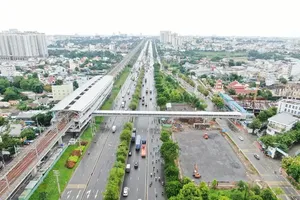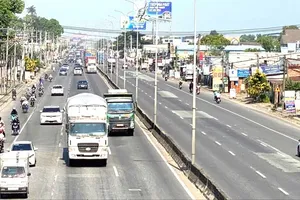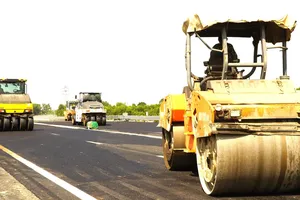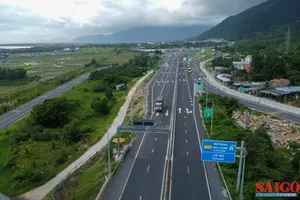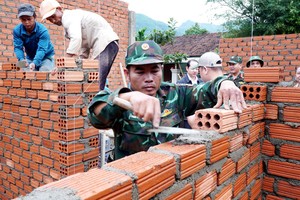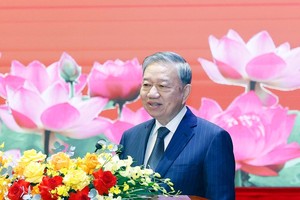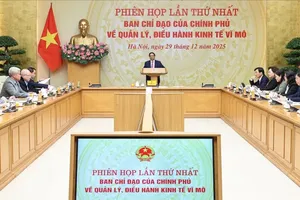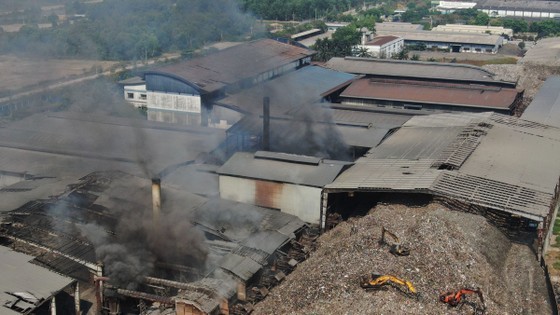 |
Tam Sinh Nghia waste treatment plant at Tam Tan Street, Thai My Commune, Cu Chi District |
Despite the endeavors undertaken by these localities to address the situation, the core issue remains unresolved.
It is not only in remote provinces but also in significant urban hubs with economic potential and technical proficiency, like Hanoi and Ho Chi Minh City, that the problem of waste treatment overload is encountered.
Waste increases by more than 10 percent annually
Hanoi, with a population exceeding 8.5 million, produces between 6,500 and 7,000 tons of household waste daily. Besides various dispersed small-scale waste treatment sites, the city has three primary waste treatment areas: Nam Son in Soc Son District, Xuan Son in Son Tay District, and Cau Dien in Nam Tu Liem District. Nevertheless, these waste treatment zones are currently grappling with an excessive load. The existing technology, infrastructure, and processing capacity have fallen short of meeting the demands, resulting in environmental pollution.
The Nam Son Waste Treatment Complex, situated within the Nam Son and Hong Ky communes of Soc Son District, covers an expanse of approximately 160 hectares and functions as a domestic waste processing zone. Over recent years, there have been instances where residents from these two communes have set up tents and obstructed roads to impede the passage of garbage trucks into the treatment area.
In a conversation with journalists, Le Thi Bui, 62, residing in Hamlet No.2, Hong Ky Commune, shared that during rainy days, the runoff from the waste spreads everywhere, and during sunny days, the odor becomes overwhelming. They have experienced numerous occasions where garbage trucks on the streets have leaked liquids, significantly impacting their daily activities. The presence of flies is quite extensive, forcing residents to resort to dining within mosquito nets to evade these insects.
In HCMC, an average of 9,700 tons of household waste is generated daily. The city has made investments in two major waste treatment zones: Phuoc Hiep in Cu Chi District and Da Phuoc in Binh Chanh District. As waste generation increases by approximately 10 percent annually, the city is also struggling with the challenge of overload. Furthermore, due to specific difficulties and obstacles, HCMC has been unable to establish a green buffer zone to separate waste treatment sites from residential areas.
Consequently, during periods of strong winds or adverse weather conditions, noxious odors emanating from the landfills negatively affect the quality of life for residents. Recently, during a meeting with voters in Cu Chi District, the National Assembly delegation of HCMC received feedback from numerous residents. They highlighted that in the past, the vicinity near the Phuoc Hiep waste treatment zone was suitable for agricultural and farming activities. However, now the area has been contaminated, making it unsuitable for any form of productive endeavors.
Confusion about technology choice
In 2012, Ca Mau Province launched the Ca Mau City waste treatment plant, designed to handle 200 tons of garbage per day, catering to waste from eight districts and cities within the province. During its operation, the facility has faced recurring malfunctions and breakdowns, occasionally requiring temporary shutdowns due to overcapacity. Over the past decade, the provincial People's Committee has consistently invited businesses to invest in and establish waste treatment facilities; however, only a few entities have responded to the call. Some interested companies encounter a maze of regulations and procedures, leading to projects being stuck in a state of limbo.
Since its establishment in 2009, the Tan Tao landfill, the largest waste collection site in Bac Lieu Province, has continually faced overload conditions. In the last four years, the landfill has been forced to cope with the disposal of 100 tons of waste daily, quadrupling its approved capacity. This excessive burden has led to frequent emission of foul odors over a wide area and the dispersion of waste-contaminated water, greatly jeopardizing the well-being of residents.
 |
Vietstar solid waste treatment plant at Tam Tan Street, Thai My Commune, Cu Chi District, Ho Chi Minh City. |
Mr. Phan Thanh Duy, the Vice Chairman of the Bac Lieu Province People's Committee, said that the region is facing numerous challenges in finding comprehensive solutions to address the problems of the overloaded waste treatment plant and landfill. Recently, the provincial People's Committee directed the Urban Services Center to handle the odor issue at the Tan Tao landfill by employing bio-based agents, using a spraying dosage four times higher than before.
Concerning fundamental solutions, Vice Chairman Phan Thanh Duy indicated that the provincial People's Committee instructed the Department of Planning and Investment to accelerate efforts to attract investment for a solid household waste treatment plant with a capacity of 200 tons per day and night. The representative from the Department of Planning and Investment of Bac Lieu Province noted that despite issuing notices, promoting initiatives, and making appeals for many years, no viable approach or investor participation had emerged thus far.
In An Giang Province, voters have persistently called for a prompt resolution to household waste treatment for several years. Mr. Nguyen Viet Tri, Director of the Department of Natural Resources and Environment, disclosed that the projects for the Phu Tan solid waste treatment plant cluster, with a daily capacity of 120 tons, and the Chau Doc City solid waste treatment plant, with a daily capacity of 195 tons have completed the bidding process and selected contractors. However, the finalization of contract negotiations and discussions is still pending.
Meanwhile, according to the Department of Natural Resources and Environment of Kien Giang Province, Phu Quoc City is daily disposing of approximately 200 tons of household waste. Local authorities have designated two land parcels spanning tens of hectares in Ham Ninh Commune and An Thoi Ward for the establishment of waste treatment facilities. However, as of now, no investor has shown interest.
More recently, the People's Committee of Ben Tre Province declared a state of emergency in response to an environmental crisis at the An Hiep landfill in Ba Tri District. This landfill has become overwhelmed due to the additional waste received from neighboring landfills in three localities within the province, leading to the seepage of leachate and the dispersion of odors into the environment, thereby impacting the lives of the residents.

